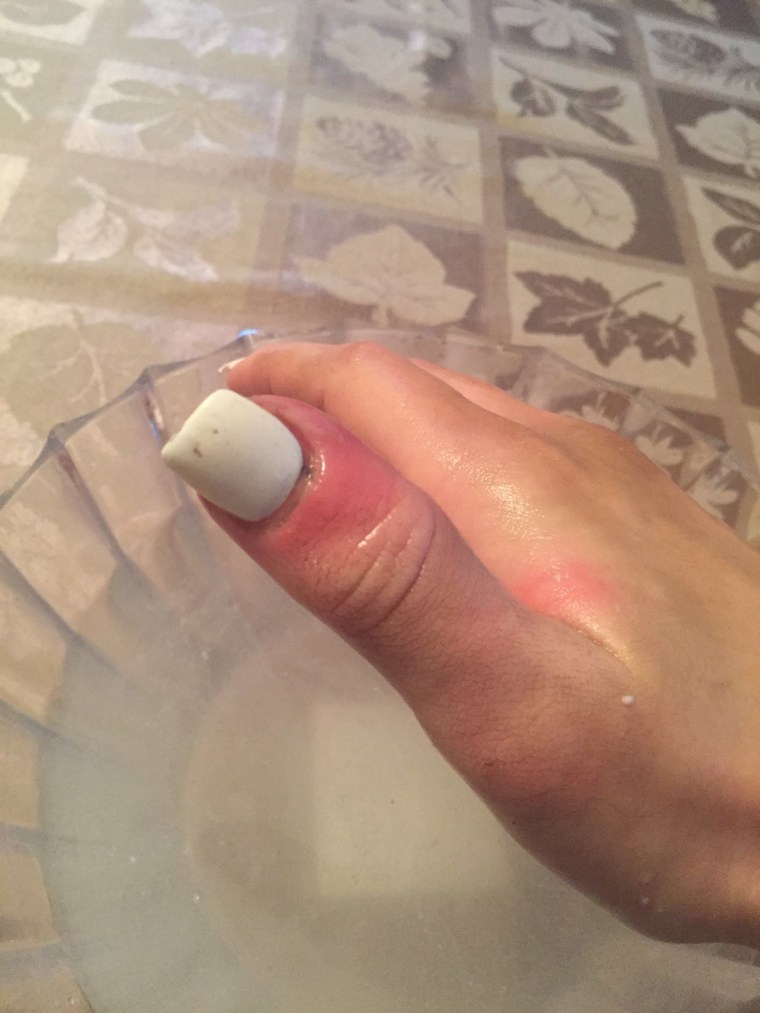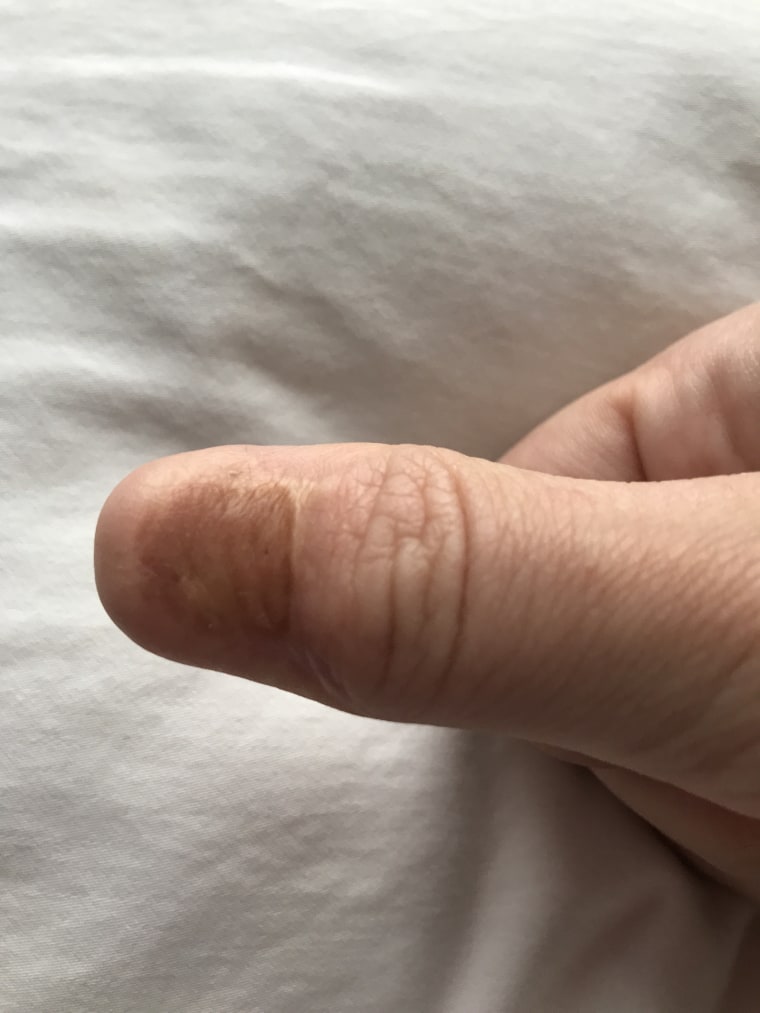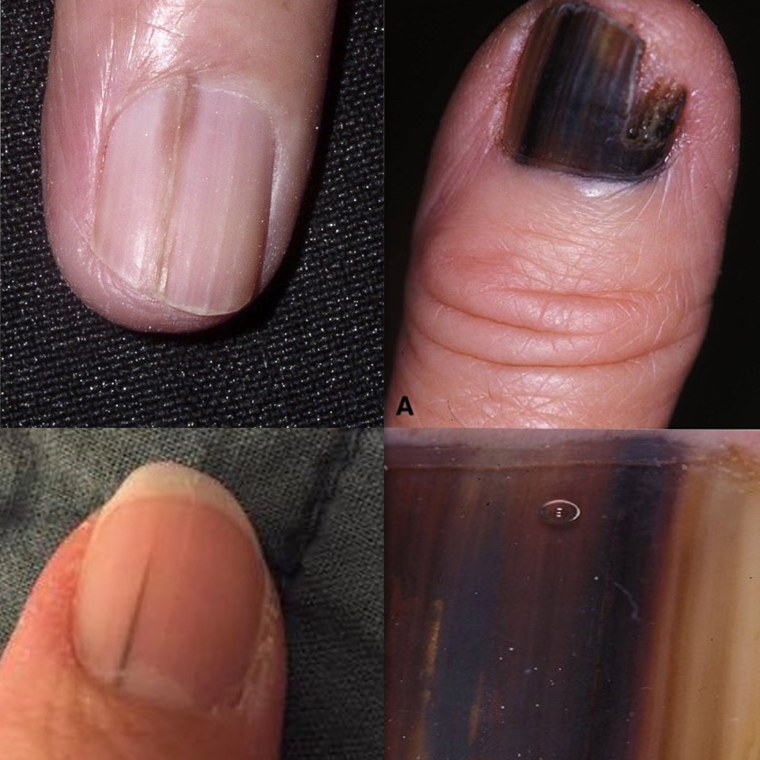Karolina Jasko has a family history of melanoma, so she's no stranger to paying attention to her skin. Her mother — who battled the deadliest form of skin cancer twice and recovered — has always been vigilant about checking Jasko’s moles for any changes.
But melanoma was still able to sneak up on Jasko in a spot neither she nor her mom suspected: one of Jasko’s nails.
Experts like Dr. Vishal Patel, assistant professor of dermatology at the George Washington University School of Medicine & Health Sciences in Washington, D.C., worry such cases may be on the rise with the popularity of gel manicures that require the polish to be hardened under ultraviolet light.
“It’s like tanning beds for your hands,” Patel, who is also the director of the cutaneous oncology program at the GW Cancer Center, told TODAY. He was not involved in Jasko’s case, but commented in general. "We’re seeing a lot of patients having not only melanomas, but all types of skin cancers around the finger tips and the cuticles," he said.
Even just short periods of a few minutes exposed to UV light can “theoretically" increase skin cancer risk "because we know that UVA ray exposure increases your risk of skin cancer, and you have to have UVA exposure to cure a gel manicure," said Dr. Chris Adigun, a dermatologist in Chapel Hill, North Carolina, who specializes in nail disorders and contributed expert advice on the safety of gel manicures for the American Academy of Dermatology.
Adigun told TODAY that part of the risk of gel manicures is that the UV exposure may add up over time, as some people, like Jasko, get it done multiple times a month.
A recent study found that the UV light emitted when curing gel nails at the salon can actually mutate DNA and cause cell damage and death. These results were observed in cells that had two 20-minute sessions in the UV nail polish dryer in one day, as well as those that had one 20-minute session a day for three days.
Maria Zhivagui, Ph.D., who co-authored the study, said the findings were so strong that she was going to stop getting gel manicures.
"I started using gel manicures periodically for several years," she said in a statement. "Once I saw the effect of radiation emitted by the gel polish drying device on cell death and that it actually mutates cells even after just one 20-minute session, I was surprised. I found this to be very alarming, and decided to stop using it."
The study authors noted that the results don't prove a connection between gel manicures and cancer since the study used cell line models, which don't exactly re-create what happens in real life. But the study and previous research "strongly suggest that radiation emitted by UV-nail polish dryers may cause cancers of the hand and that UV-nail polish dryers, similar to tanning beds, may increase the risk of early-onset skin cancer," the authors wrote.
A straight vertical line with a "purplish" tint
Jasko, now 25, first became aware of the unusual spot in 2016 when she was a senior in high school. She’d been getting her nails done once or twice a month for a couple of years, complete with acrylics — artificial nails applied on top of her natural nails — plus a gel polish that was cured with UV light.
When the acrylics were removed during one particular visit, the technician pointed out what seemed to be a bruise on her right thumb nail. It looked like a perfectly straight thin vertical line drawn with a pencil from the top to the bottom of her nail, with “a purplish tint” to it, Jasko recalled.
She didn’t think much about it. But about a week later, her nail became infected, swollen and red, which led her to see her doctor. The infection didn’t alarm him, but the mysterious streak on her nail did.

Jasko was immediately referred to a dermatologist who told her she needed to undergo a biopsy that same day at Northwestern Memorial Hospital in Chicago.
“It was overwhelming because everything happened so quick,” Jasko said. “It was so scary. ... My mom was like, ‘I can’t believe that I never even thought that it could be in your nail.’”
The portion of her thumb nail with the line was removed during the biopsy, which confirmed it was melanoma. Jasko had to return for surgery to remove the whole nail matrix. Doctors told her it was possible they might also have to amputate the whole thumb, but were able to save the digit. A skin graft from her groin area covered her thumb, which no longer has a nail.

The nail infection — which was unrelated to the melanoma, but led Jasko to see a doctor — may have saved her life, doctors told her.
“They still don’t know where the infection came from. They said that was like a sign from God ... because if I would have waited longer and not come in with that, it could have been possible the melanoma would have spread,” Jasko said. She went on to become Miss Illinois 2018 and competed in the Miss USA pageant.
What to know about nail melanoma
Melanoma on the extremities — nails, hands and feet — is the rarest subtype of the skin cancer, accounting for less than 5% of all melanomas, Patel said. But it makes up about a third of all the melanomas that African Americans, Indians, Asians and other people with darker skin develop, which is a ten-fold increase compared to the general population, he noted.
This type of cancer — called acral lentiginous melanoma — tends to be more aggressive than other melanomas. It killed reggae legend Bob Marley at 36 after it showed up as a dark spot under his toenail.

The main symptom is melanonychia, or a pigmented vertical streak on the nail. Some people have likened it to a line drawn by a Sharpie. That doesn’t mean it's always automatically worrisome because such streaks are much more common in patients with darker skin, Patel noted.
“When you have multiple, it’s reassuring because that may be a ‘signature’ of your nail beds,” he said.
But if a vertical stripe suddenly appears on a nail or it’s changing, that’s something a doctor should check out. Pigment extending from the nail portion onto the cuticle and nearby skin, which is called a Hutchinson's sign, is also of concern.
Some doctors say nail melanoma often develops on the thumb of one’s dominant hand, or big toe of one’s dominant side, but Patel has seen it on all digits and believes all of the nails are equally potentially affected.
This type of melanoma is more driven by genetics and family history than sun exposure, but people should still follow sun-safe practices, he added:
- Be careful about UV exposure, including at the nail salon. Wear fingerless gloves with an ultraviolet protection factor or apply sunscreen to your hands at least 15 minutes before a gel manicure.
- When outside, apply sunscreen to the whole body, including around your nails and on your hands.
- Wear sunscreen and possibly gloves during your daily commute: “If you’re a driver who has your hands out in a one-and-a-half-hour commute, you’re getting UV radiation exposure right to the backs of the hands and the nails,” Patel said. “Some of these things sound crazy, but the cumulative exposure over time (matters).”
- Remove nail polish before going to your annual skin check so a doctor can see your nails.
With Jasko's family history of melanoma, doctors can’t say how much of a role her regular UV exposure at the nail salon played. She now paints her nails with regular polish and skips the gel manicures. She also gets her skin checked every four months and is doing well.
"I am still getting my check-ups for my skin, and it is still incredibly important to me," Jasko said. "I will be doing this for the rest of my life to ensure I am taking all precautions necessary. I still highly recommend for everyone to add a dermatologist to their list of doctors because early detection saved my life."
